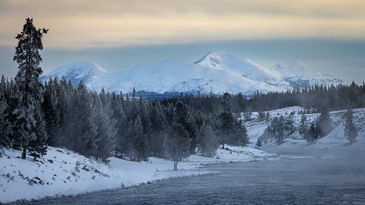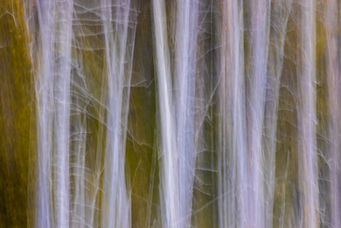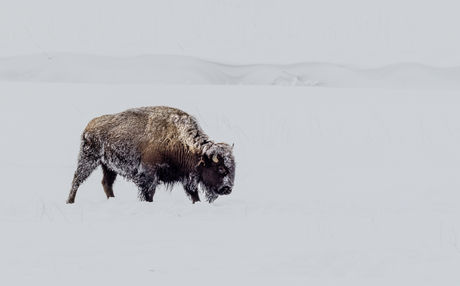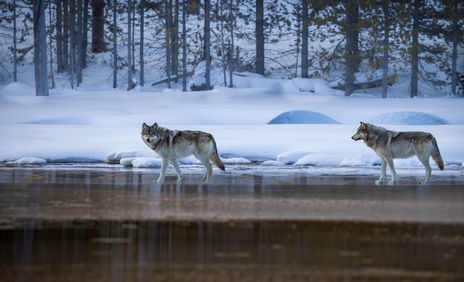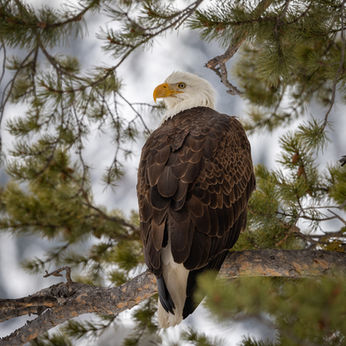Yellowstone in Winter
These following photographs were taken on a trip to Yellowstone national park in January 2022 with Antony Spencer, organised through Lightandland. We stayed for the first four nights in West Yellowstone just outside the western entrance to the park. The roads on this side of the park are closed to general traffic during the winter months but are prepared to take snowmobiles, snow cats and other suitable vehicles for organised tours. There are only five of us on this trip, including three Americans, which is a nice number to fill a bombardier snowcat (built in Québec in the 1960s and since restored) which is equipped with tracks and has skis at the front to steer - but not very easily! For the second half of the trip, we were based at Gardner on the north side of the park and we were able to drive our own vehicle on the road through the park. We did not do very much 'landscape' photography on this trip. Most of our time was spent following and tracking the wildlife and our stops to photograph the landscape were opportunistic. It was a bit of an effort to climb in and out of the snow cat or the car and we occasionally had to use crampons so we lost interest in using tripods and almost all of these photographs are hand held often with long lenses.
Much of the soil within the Yellowstone Caldera is the product of hardened lava flows from the region’s volcanic past and is unsuitable for many types of trees. The central part of the park is characterized by miles upon miles of lodgepole pine, a tree which thrives in the slightly acidic soil of the caldera. The roots of lodgepole pine extend sideways rather than deep into the ground - an advantage in the caldera where the topsoil is very thin and contains few nutrients. Dead lodgepole pines near some hydrothermal areas look as if they are wearing white anklet socks, at one time called “bobby socks.” The dead trees soak up the mineral-laden water. When the water evaporates, the minerals are left behind, turning the lower portion of the trees white.
What's the difference between a buffalo and a bison? You can't wash your hands in a buffalo.
Though the terms are often used interchangeably, buffalo and bison are distinct animals. Old World “true” buffalo (Cape buffalo and water buffalo) are native to Africa and Asia. Bison are found in North America and Europe. Both bison and buffalo are in the bovidae family, but the two are not closely related. How did the names get so mixed up? Historians believe that early European explorers are to blame, though the details are a bit murky. According to the National Park Service, it’s possible it stemmed from the French word boeuf, meaning beef. Others posit that bison hides resembled buff coats commonly worn by military men at the time, inspiring the name. Whatever the case, the misnomer stuck.
Bison have large humps at their shoulders and bigger heads than buffalo. They also have beards, as well as thick coats which they shed in the spring and early summer. Another simple way to tell a buffalo from a bison is to look at its horns. Cape buffalo horns resemble a handlebar moustache; they have a thick, helmet-like base and curl down, then back up. A water buffalo’s horns are large, long and curved in a crescent, while a bison’s horns are typically sharp and shorter than the average buffalo’s.
The bison once roamed North America in the tens of millions and was a critical part of Native American culture: every part of the bison provided something for their way of life and native people hunted bison on foot. As European Americans settled the west in the 1800s, the U.S. Army campaigned to remove the tribes by taking away their main food source: bison. Hundreds of thousands of bison were killed by U.S. troops and market hunters. By the late 1880s, the great herds were nearly gone. Some animals found protection on private ranches. In the Yellowstone area, their numbers dwindled to about two dozen bison. In one of the first efforts to preserve a wild species, the National Park Service (NPS) set about recovering the bison population. In 1902, they purchased 21 bison from private owners and raised them in Mammoth and then at the historic Lamar Buffalo Ranch. Eventually, these animals began to mix with the park’s free-roaming population and by 1954, their numbers had grown to roughly 1,300 animals. Bison reproduce at relatively high rates so managers limited growth with frequent culling. Hundreds of animals were removed to start or supplement herds on other public and tribal lands. A moratorium on culling in 1969 resulted in the population increasing from 500 to 3,000 in 1990 and as numbers increased, they left the park in greater numbers creating challenges for people sharing that landscape, both in terms of human safety and because bison want to eat the same grass ranchers grow to feed their livestock.
Bison also carry brucellosis, a disease that can be transmitted to livestock. In 1995, Montana sued the NPS for allowing bison to leave the park, following which Montana and the federal government developed a plan to guide the management of bison in and around Yellowstone. As part of this plan, various agencies work to sustain a wild, wide-ranging bison population and reduce the risk of brucellosis transmission from bison to cattle since when the bison population has ranged between 2,400 and 5,500 animals. There have subsequently been no cases of bison transmitting brucellosis directly to cattle. Although Montana now allows bison to occupy some habitat adjacent to the park that was previously off-limits, lack of tolerance for wild bison in most areas outside Yellowstone continues to limit the restoration of this iconic species. Large parts of their historic winter ranges are no longer available due to human development, and because states only allow limited numbers of bison in areas near the park.
By 1926, as a result of federal and state predator control efforts, gray wolves (Canis lupus) were officially eliminated from Yellowstone In the ensuing decades, our understanding of large predators and their role in healthy ecosystems changed, and Northern Rocky Mountain wolves were eventually listed under the Endangered Species Act (ESA) in 1973. With ESA listing came the goal of restoring wolves to their historic range, and in 1995 and 1996, following many years of public planning and input, a total of 31 wolves, captured in Alberta and British Columbia, were reintroduced to Yellowstone. Wolves flourished amidst Yellowstone's abundant prey and expansive, protected wilderness. Wolf reintroduction in Yellowstone was part of the much larger Northern Rocky Mountain wolf recovery effort. This included a simultaneous wolf reintroduction in central Idaho and ongoing protection for a naturally recovering population in north-west Montana. By 2002, the US Fish and Wildlife Service's recovery goals were met: the Northern Rockies were now home to 30 breeding wolf pairs, uniformly distributed throughout these three Rocky Mountain recovery areas for three successive years. While Yellowstone's portion of the wolf population remains protected within its boundaries, a regulated wolf hunting and trapping season now takes place throughout Montana, Idaho, and Wyoming, including in areas adjacent to the National Parks.
We were a mite lucky to get this close to the wolves to capture these images (There is no crop) but, having found them, we spent the best part of two days following them through the park from the West Yellowstone entrance.
The Wapiti Lake Pack was founded by 755M in 2014. In reality, 755M had been travelling around much of the Northern Range, not joining a pack or finding a mate for about 2 years. This former alpha male of the Lamar Canyon Pack returned to the park in winter 2012 from a trip east and joined up with 759F from Mollie's Pack, who later left him. After being alone for a few months, 755M was seen with an uncollared gray female in April 2013, then later with 889F. 755M appeared to have joined Junction Butte, but split off with 889F in 2014. The pair spent time in the Hellroaring area before 889F was harvested [?] outside of the Park. Finally, in 2015, 755M settled down in Hayden Valley with an uncollared gray female where they denned and had pups. Mollie's wolves joined the small pack in 2016 and 755M was seen in numerous places around the Northern Range. In 2017, the famous White Alpha Female's daughter became alpha of Wapiti Lake pack. Both 1091F and the White Female had litters in 2017. The main Wapiti group, including 1014M and the White Female, remained in the Hayden and Norris area throughout the winter. The pack denned in 2019 and produced two litters for a total of 9 pups. At the end of the year the pack was the largest in Yellowstone with 19 wolves. [Updated 1/2020]
We were driving back in the evening to West Yellowstone when we spotted a line of vehicles parked at the side of the road. We therefore stopped to see what the action was. This eagle was perched in a tree very close to the side of the road and was seemingly not bothered by the dozens of people crowding closer and closer to get the photograph. Eventually however of course he flew away for some peace and quiet.
I had to check - Bald or Golden? Most people believe these two birds are closely related, but surprisingly this isn’t the case. Bald eagles belong to a group called “fishing eagles,” and are more closely related to kites. Golden eagles are more closely related to hawks called “Buteos,” such as red-tailed hawks. Adult golden and bald eagles have distinguishing characteristics in their colouring making it easy to identify the species. Both are large birds with dark brown bodies. The adult bald eagle has a noticeable white head and tail while the golden eagle has a brown head with “golden” feathers on the back of their necks. The adult bald eagle has a large, yellow beak, while the golden has a slightly smaller black beak. Golden eagles are referred to as booted eagles, since they are feathered all the way down their legs to the tops of their feet, while the bald eagle’s feathers stop a few inches from the tops of their feet.
Mammoth Hot Springs is a complex of hot springs on a hill of travertine (A form of limestone) created over thousands of years as hot water from geothermal vents cooled and deposited calcium carbonate (over two tons flow into Mammoth each day in a solution). The hot water that feeds Mammoth comes from Norris Geyser Basin via a fault line that runs through limestone which is the source of the calcium carbonate. The superheated water cools slightly before surfacing at about 80°C. Algae living in the warm pools have tinted the travertine shades of brown, orange, red, and green. This is the largest known carbonate-depositing spring in the world. The Mammoth Hotel is built upon an old terrace formation. There was some concern when construction began in 1891 on the fort site that the hollow ground would not support the weight of the buildings. This area has been thermally active for several thousand years.
We and several hundred other tourists spotted these moose close to the road at the top end of the Lamar Valley Road above Gardner. They wanted to cross the road but were frustrated by the numbers of vehicles queueing up along it watching them. Eventually the humans figured it out and made a break in the traffic for them to cross, so they disappeared into the hills. I took this shot in a brief moment when two of the young males headed off against each other but it was not a serious encounter.
Yellowstone moose are the smallest of four subspecies of moose (Alces alces shirasi) in North America. Found in forested areas and willow flats from south-eastern British Columbia to southern Colorado, they are better adapted to survival in deep snow than other ungulates in Greater Yellowstone (There are also Elk). Except during the rut, moose are usually found alone or in small family groups. This behaviour, and their use of habitat where they are often well concealed, impedes accurate estimates of population size and distribution. I think that these were the only ones that we saw.
Every photographer that comes to Yellowstone National Park takes a photograph of this tree in the Hayden valley. I'm not entirely sure that mine is the best example but it cannot be too difficult to make an image of a solitary tree .. or can it?
I did some engineering in Lightroom for this to trial in black and white. Tony has a wonderful photograph of this tree with bison coming over the hill on the horizon but then he would, wouldn't he, he comes here often enough to get that opportunity.
The coyote (Canis latrans), which we saw this once on this trip, is a species of canine native to North America. It is smaller than its close relative, the wolf. It is listed as least concern by the International Union for Conservation of Nature, due to its wide distribution and abundance throughout North America. The species is versatile, able to adapt to and expand into environments modified by humans. It is enlarging its range by moving into urban areas in the eastern U.S. and Canada. It has 19 recognized subspecies. The average male weighs 8 to 20 kg. Their fur color is predominantly light gray and red or fulvous interspersed with black and white, though it varies somewhat with geography. It is highly flexible in social organization, living either in a family unit or in loosely knit packs of unrelated individuals. Primarily carnivorous, its diet consists mainly of deer, rabbits, hares, rodents, birds, reptiles, amphibians, fish, and invertebrates, though it may also eat fruits and vegetables on occasion. Its characteristic vocalization is a howl made by solitary individuals. Humans are the its greatest threat, followed by cougars and gray wolves. In spite of this, coyotes sometimes mate with gray, eastern, or red wolves, producing "coywolf" hybrids. Genetic studies show that most North American wolves contain some level of coyote DNA. Unlike wolves, which have seen their public image improve, attitudes towards the coyote remain largely negative.
Hot springs are the most common hydrothermal features in Yellowstone. Beginning as precipitation, the water of a hot spring seeps through the bedrock underlying Yellowstone and becomes superheated at depth. An open plumbing system allows the hot water to rise back to the surface unimpeded. Convection currents constantly circulate the water, preventing it from getting hot enough to trigger an eruption. At times, fierce, boiling waters within a hot spring (such as Crested Pool) can explode, shooting water into the air, acting much like a geyser. It is believed, however, that in the case of Crested Pool, no constrictions block the flow of water to the surface. The spring's wide mouth and 14 m depth provide a natural conduit for superheated water to circulate continuously to the surface. Many of the bright colours found in Yellowstone's hydrothermal basins come from thermophiles—microorganisms that thrive in hot temperatures. So many individual microorganisms are grouped together—trillions!—that they appear as masses of colour. Different types of thermophiles live at different temperatures within a hot spring and cannot tolerate much cooler or warmer conditions. Yellowstone's hot water systems often show distinct gradations of living, vibrant colours where the temperature limit of one group of microbes is reached, only to be replaced by a different set of thermophiles.

